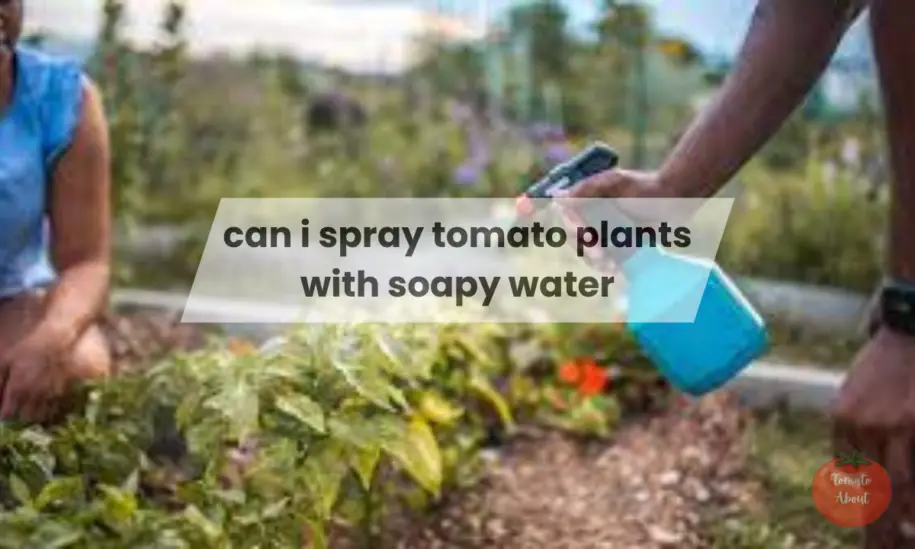Key Takeaways
- Yes, you can safely spray tomato plants with a diluted soap and water solution as an organic pest control method.
- Soap works as an insecticide by breaking down the waxy coating on soft-bodied insects, leading to their dehydration and death.
- Use a mild, all-natural soap and test a small area of your plants before spraying the entire plant to avoid potential damage.
- Apply the soapy water early in the morning or late afternoon, ensuring thorough coverage on both sides of the leaves and stems.
- To minimize potential risks, limit soapy water sprays to once a week, avoid using them during hot, dry weather or on flowering plants, and consider alternating with other organic pest control methods like neem oil.
As a home gardener, you want your tomato plants to thrive and produce an abundance of delicious tomatoes. However, dealing with pests like aphids, whiteflies, spider mites, and others can be extremely frustrating.
You may have heard that spraying plants with soapy water can help get rid of these annoying critters. But is this really safe for your tomato plants? Let’s dive into the details.
So, Can I Spray Tomato Plants with Soapy Water
Yes, you can safely spray tomato plants with a diluted soap and water solution as an organic pest control. Use a mild soap, test first, and rinse the leaves after a few hours to avoid leaf damage. Limit spraying to once a week and alternate with other organic pesticides.
How Soapy Water Works as an Insecticide
Using a diluted soap solution as a pest control spray is not a new idea. The key insecticidal ingredient in soap is the fatty acids present in all types of soaps and detergents.
When soft-bodied insects like aphids come into direct contact with these fatty acids, it breaks down the waxy coating on their exoskeleton. This leads to desiccation and dehydration, killing the insects.
For controlling garden pests, it’s crucial to use soap without added ingredients that could potentially harm your plants.
Avoid dish soap or laundry detergents as these often contain degreasing agents or other chemicals that can damage plant tissues. Mild liquid castile soaps made from all-natural vegetable or plant oils are ideal for an insecticidal spray. Liquid dish soap without degreasers will also work well.
Creating a Soapy Spray Solution for Tomato Plants
To make an effective insect-killing spray, use approximately 1-2 teaspoons of liquid soap per 1 quart of water. For a larger batch, mix 1-2 tablespoons of soap with 1 gallon of water. Thoroughly mix or shake the solution until the soap fully dilutes into the water.
Some gardeners also like to add a few drops of essential oils like peppermint, eucalyptus, or lemon oil to make the soap spray even more repellent to soft-bodied insects. The strong scent overwhelms their chemical receptors.
No matter what soap product you choose, it’s wise to first test spray a small portion of a plant and wait 24-48 hours to check for any damage before spraying your tomato plants. If too high of a soap concentration is used, leaf burn can occur. Start dilute and test first.
How to Apply Soapy Water Sprays to Tomato Plants
When applying your soap spray to tomato plants, it’s best practice to do so early in the morning or late afternoon when the sun is less intense. This lessens the chances of the soap solution damaging leaves while it’s wet. Be sure to thoroughly coat the upper and lower surfaces of leaves, as well as stems, branches, and anywhere else pests may be hiding out.
Pay extra attention to the undersides of leaves, as that’s where many pests like to congregate. Spray until the soap solution starts dripping off the leaves. Let the spray solution fully coat plants and dry on the surfaces for at least 2-3 hours before rinsing it off with a strong stream of water from your hose. This prevents excessive soap residue buildup on the foliage.
For best results, experts recommend spraying tomato plants about once weekly for 3-4 weeks max. This routine helps catch newly hatching generations of pests before they can reproduce again. Be sure to routinely check the undersides of leaves and spot spray any insects you discover between weekly treatments.
Understanding the Potential Risks of Soapy Sprays
While soapy water sprays are far gentler than harsh synthetic chemical pesticides, they do carry some potential risks:
- Leaf burn – Excessive soap residue on foliage can lead to brown spots or scorched areas on tomato leaves. Always test spray plants first and start with lower soap concentrations.
- Stripping waxy plant oils – Frequent spraying can gradually strip away the natural waxy cuticle on leaves that helps protect against water loss. Overuse of soaps can lead to desiccation.
- Soil contamination – Letting soapy runoff reach the soil can negatively impact beneficial organisms like earthworms or soil bacteria. Avoid excessive runoff when spraying.
To minimize these risks when using soap sprays, limit treatments to once weekly for a month maximum. Rinse leaves after 2-3 hours to prevent leaf burn issues. And consider alternating soapy water with other organic pest control sprays like neem oil to avoid over-reliance on soaps alone.
When to Avoid Using Soap-Based Leaf Sprays
There are a few situations when soapy water sprays may not be the best idea for your tomato plants:
- During hot, dry weather or drought conditions. Soap and high heat/dryness don’t mix well due to increased chances of leaf burn.
- On young seedlings or newly transplanted tomatoes. Their tender foliage is extra sensitive to potential damage from soaps.
- If pollinators are active in the garden. The soap residue can negatively impact honeybees and other beneficial pollinating insects. Avoid spraying when plants are flowering.
- After heavy rains. No need to spray if rain already washed away existing pest populations. Let plants dry out first.
- If foliage shows damage from previous soap applications. Discontinue use if any leaf burn occurs and switch to a different organic pest control method.
Other Organic Pest Control Options for Tomatoes
While intermittent soapy water sprays can help manage soft-bodied insects like aphids, they aren’t as effective on other tomato pests like hornworms, cutworms, cabbage loopers, Colorado potato beetles, flea beetles, and more. Here are some other organic solutions to try:
Neem Oil
Derived from the seeds of the neem tree, neem oil is a broad-spectrum organic pesticide that repels and kills many harmful biting and sucking garden insects. It coats plants with a sticky residue that pests want to avoid. Completely coat all leaf surfaces for best results.
Pyrethrin Insecticide
Pyrethrin is a botanical insecticide made from chrysanthemum flowers. It works quickly to knock down populations of aphids, spider mites, whiteflies, leafhoppers, and other soft-bodied insects. Just be sure to spray in the evening to avoid harming pollinators.
Kaolin Clay
This white mineral clay spray is effective when applied to leaves, stems, and other above-ground plant parts. The powdery coating deters pests from landing on and consuming plants. Reapply after heavy rains.
Floating Row Covers
Placing a thin, breathable fabric over plants creates a protective physical barrier that keeps most pests from reaching the plants. Works against everything from flies to beetles.
Beneficial Insects
Let nature control pests by purchasing and releasing beneficial predator insects like ladybugs, lacewings, minute pirate bugs, and predatory mites. They’ll feed on problem insects.
Diatomaceous Earth
This powdery dust made from fossilized marine life can be sprinkled around plants. It abrades and destroys soft-bodied pests like slugs, earwigs, millipedes, and ants on contact. Avoid breathing in the dust.
Frequently Asked Question
Can soapy leaf sprays indeed damage my tomato plants if overused?
Yes, excessive residues of soap left on foliage can lead to leaf burn. Start conservatively with lower soap concentrations. Test first and rinse leaves after a few hours. Avoid spraying during hot, dry weather. Don’t solely rely on soap sprays for pest control.
What garden pests is soapy water best at controlling on tomatoes?
Soft-bodied insects with delicate exoskeletons like aphids, whiteflies, mealybugs, psyllids, and spider mites. Soaps are less effective against worms, beetles, or other pests with tougher outer coverings.
Is it necessary to rinse my tomato plants after applying soapy water?
Yes, it’s recommended to rinse leaves with clean water after 2-3 hours of leaving the soap spray on. This prevents buildup of excessive soap residue that can burn leaves. The soap only needs brief contact to kill soft-bodied pests before rinsing.
Can I spray my tomato plants with soapy water while they are flowering?
Avoid spraying insecticidal soaps during flowering, as the soap residue can harm pollinators like bees that are actively visiting the blooms. Either sprays early in growth before buds form or after fruit sets.
Wrapping up
Spraying tomato plants intermittently with a diluted soap-and-water solution can provide an effective, environmentally friendly way to manage soft-bodied insect pests like aphids, whiteflies, and spider mites.
But be sure to follow the recommended guidelines on soap concentration, testing, timing, and rinsing leaves after treatment. Alternate soapy sprays with other organic pest controls for the healthiest tomato plants and highest yields.



